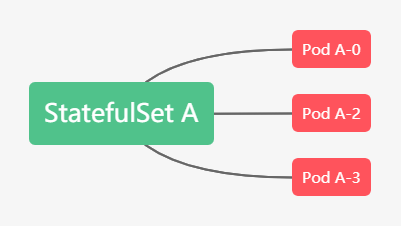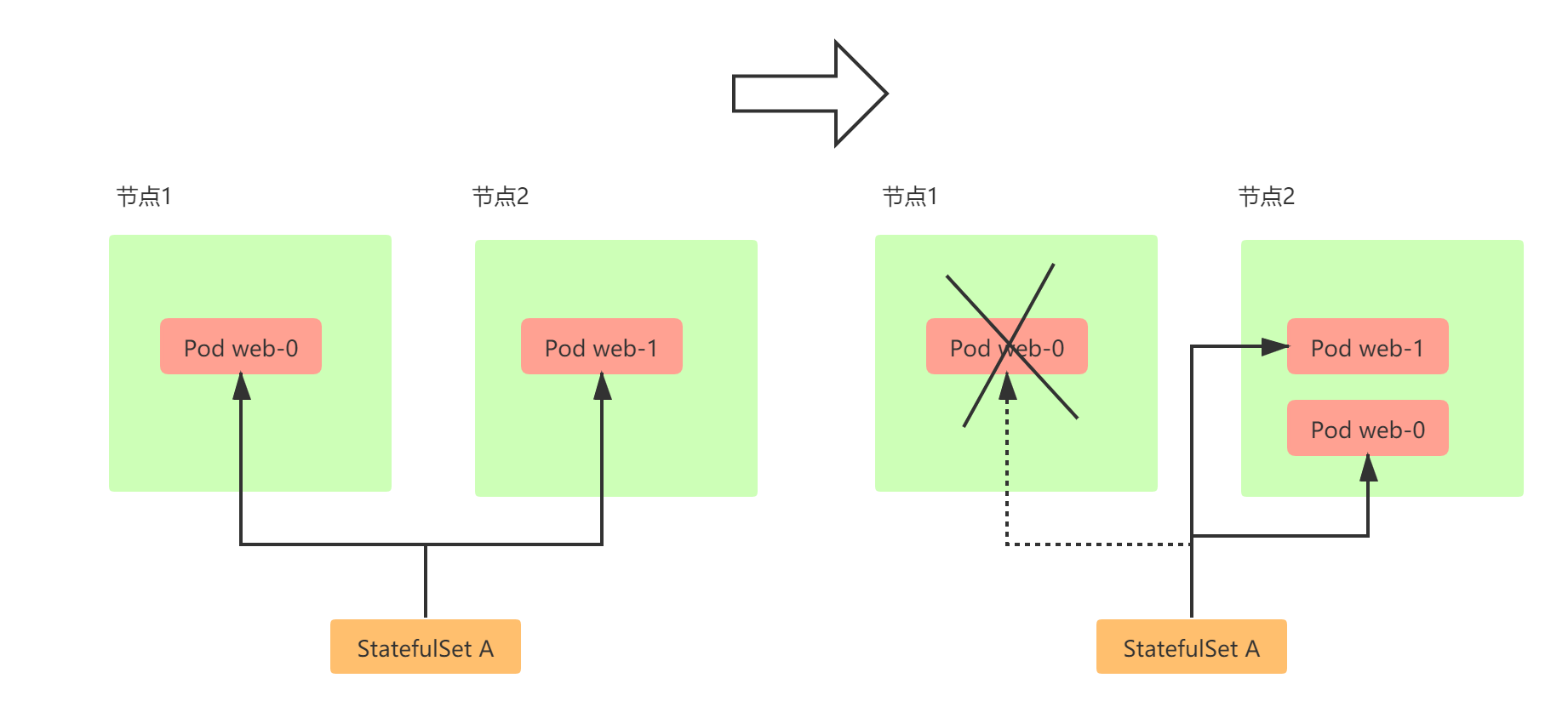转载请声明出处哦~,本篇文章发布于luozhiyun的博客:https://www.luozhiyun.com

在上一篇中,讲解了容器持久化存储,从中我们知道什么是PV和PVC,这一篇我们讲通过StatefulSet来使用它们。
这一篇中我重新按照源码重新撸了一遍,希望能加深对k8s的理解,源码版本是1.19,在阅读源码的时候可以参照着一起看会比较便于理解。
StatefulSet概念
我们在第三篇讲的Deployment控制器是应用于无状态的应用的,所有的Pod启动之间没有顺序,Deployment可以任意的kill一个Pod不会影响到业务数据,但是这到了有状态的应用中就不管用了。
而StatefulSet就是用来对有状态应用提供支持的控制器。
StatefulSet创建的pod具有唯一的标识和创建和删除顺序的保障,从而主要做到了两件事情:
- 提供稳定的网络标识。一个StatefulSet创建的每个pod都有一个从零开始的顺序索引。这样可以方便通过主机名来定位pod,例如我们可以创建一个headless Service,通过Service记录每个pod的独立DNS记录来定位到不同的pod,由于pod主机名固定,所以DNS记录也不会变。如下:

- 提供稳定的专属存储。一个StatefulSet在创建的时候也可以声明需要一个或多个PVC,然后pvc会在创建pod前绑定到pod上。StatefulSet在缩容的时候依然会保留pvc,这样不会导致数据的丢失,在扩容的时候也可以让pvc挂载到相同的pod上。
StatefulSet 的核心功能,就是通过某种方式记录这些状态,然后在 Pod 被重新创建时,能够为新 Pod 恢复这些状态。
提供稳定的网络标识
在k8s中,Service是用来将一组 Pod 暴露给外界访问的一种机制。Service可以通过DNS的方式,代理到某一个Pod,然后通过DNS记录的方式解析出被代理 Pod 的 IP 地址。
如下:
apiVersion: v1
kind: Service
metadata:
name: nginx
labels:
app: nginx
spec:
ports:
- port: 80
name: web
clusterIP: None
selector:
app: nginx这个Service会通过Label Selector选择所有携带了 app=nginx 标签的 Pod,都会被这个 Service 代理起来。
它所代理的所有 Pod 的 IP 地址,都会被绑定一个这样格式的 DNS 记录,如下所示:
<pod-name>.<svc-name>.<namespace>.svc.cluster.local所以通过这个DNS记录,StatefulSet就可以使用到DNS 记录来维持 Pod 的网络状态。
如下:
apiVersion: apps/v1
kind: StatefulSet
metadata:
name: web
spec:
serviceName: "nginx"
replicas: 2 # by default is 1
selector:
matchLabels:
app: nginx # has to match .spec.template.metadata.labels
template:
metadata:
labels:
app: nginx # has to match .spec.selector.matchLabels
spec:
containers:
- name: nginx
image: nginx:1.9.1
ports:
- containerPort: 80
name: web这里使用了serviceName=nginx,表明StatefulSet 控制器会使用nginx 这个Service来进行网络代理。
我们可以如下创建:
$ kubectl create -f svc.yaml
$ kubectl get service nginx
NAME TYPE CLUSTER-IP EXTERNAL-IP PORT(S) AGE
nginx ClusterIP None <none> 80/TCP 10s
$ kubectl create -f statefulset.yaml
$ kubectl get statefulset web
NAME DESIRED CURRENT AGE
web 2 1 19s然后我们可以观察pod的创建情况:
$ kubectl get pods -w -l app=nginx
NAME READY STATUS RESTARTS AGE
web-0 1/1 Running 0 76m
web-1 1/1 Running 0 76m我们通过-w命令可以看到pod创建情况,StatefulSet所创建的pod编号都是从0开始累加,在 web-0 进入到 Running 状态、并且细分状态(Conditions)成为 Ready 之前,web-1 会一直处于 Pending 状态。
然后我们使用exec查看pod的hostname:
$ kubectl exec web-0 -- sh -c 'hostname'
web-0
$ kubectl exec web-1 -- sh -c 'hostname'
web-1然后我们可以启动一个一次性的pod用 nslookup 命令,解析一下 Pod 对应的 Headless Service:
$ kubectl run -i --tty --image busybox:1.28.4 dns-test --restart=Never --rm /bin/sh
$ nslookup web-0.nginx
Server: 10.68.0.2
Address 1: 10.68.0.2 kube-dns.kube-system.svc.cluster.local
Name: web-0.nginx
Address 1: 172.20.0.56 web-0.nginx.default.svc.cluster.local
$ nslookup web-1.nginx
Server: 10.68.0.2
Address 1: 10.68.0.2 kube-dns.kube-system.svc.cluster.local
Name: web-1.nginx
Address 1: 172.20.0.57 web-1.nginx.default.svc.cluster.local如果我们删除了这两个pod,然后观察pod情况:
$ kubectl delete pod -l app=nginx
$ kubectl get pod -w -l app=nginx
web-0 1/1 Terminating 0 83m
web-1 1/1 Terminating 0 83m
web-0 0/1 Pending 0 0s
web-1 0/1 Terminating 0 83m
web-0 0/1 ContainerCreating 0 0s
web-0 1/1 Running 0 1s
web-1 0/1 Pending 0 0s
web-1 0/1 ContainerCreating 0 0s
web-1 1/1 Running 0 1s当我们把这两个 Pod 删除之后,Kubernetes 会按照原先编号的顺序,创建出了两个新的 Pod。并且,Kubernetes 依然为它们分配了与原来相同的“网络身份”:web-0.nginx 和 web-1.nginx。

但是网络结构虽然没变,但是pod对应的ip是改变了的,我们再进入到pod进行DNS解析:
$ nslookup web-0.nginx
Server: 10.68.0.2
Address 1: 10.68.0.2 kube-dns.kube-system.svc.cluster.local
Name: web-0.nginx
Address 1: 172.20.0.59 web-0.nginx.default.svc.cluster.local
$ nslookup web-1.nginx
Server: 10.68.0.2
Address 1: 10.68.0.2 kube-dns.kube-system.svc.cluster.local
Name: web-1.nginx
Address 1: 172.20.0.60 web-1.nginx.default.svc.cluster.local提供稳定的专属存储
在讲存储状态的时候,需要大家掌握上一节有关pv和pvc的知识才好往下继续,建议大家看完再来看本节。
在上一节中,我们了解到Kubernetes 中 PVC 和 PV 的设计,实际上类似于“接口”和“实现”的思想。而 PVC、PV 的设计,也使得 StatefulSet 对存储状态的管理成为了可能。
比如我们声明一个如下的StatefulSet:
apiVersion: apps/v1
kind: StatefulSet
metadata:
name: web
spec:
serviceName: "nginx"
replicas: 1
selector:
matchLabels:
app: nginx
template:
metadata:
labels:
app: nginx
spec:
containers:
- name: nginx
image: nginx:1.9.1
ports:
- containerPort: 80
name: web
volumeMounts:
- name: local-volume-a
mountPath: /usr/share/nginx/html
volumeClaimTemplates:
- metadata:
name: local-volume-a
spec:
accessModes:
- ReadWriteMany
storageClassName: "local-volume"
resources:
requests:
storage: 512Mi
selector:
matchLabels:
key: local-volume-a-0在这个StatefulSet中添加了volumeClaimTemplates字段,用来声明对应的PVC的定义;也就是说这个PVC中使用的storageClass必须是local-volume,需要的存储空间是512Mi,并且这个pvc对应的pv的标签必须是key: local-volume-a-0。
然后我们准备一个PV:
apiVersion: v1
kind: PersistentVolume
metadata:
name: local-volume-pv-0
labels:
key: local-volume-a-0
spec:
capacity:
storage: 0.5Gi
volumeMode: Filesystem
accessModes:
- ReadWriteMany
persistentVolumeReclaimPolicy: Retain
storageClassName: local-volume
local:
path: /mnt/disks/vol1
nodeAffinity:
required:
nodeSelectorTerms:
- matchExpressions:
- key: kubernetes.io/hostname
operator: In
values:
- node1我把这个PV创建在node1节点上,并且将本地磁盘挂载声明为PV。
然后我们创建这个PV:
$ kubectl apply -f local-pv-web-0.yaml
$ kubectl get pv
NAME CAPACITY ACCESS MODES RECLAIM POLICY STATUS CLAIM
STORAGECLASS REASON AGE
local-volume-pv-0 512Mi RWX Retain Available default/local-vo然后我们在创建这个StatefulSet的时候,会自动创建PVC:
$ kubectl apply -f statefulset2.yaml
$ kubectl get pvc
NAME STATUS VOLUME CAPACITY ACCESS MODES STORAGECLASS AGE
local-volume-a-web-0 Bound local-volume-pv-0 512Mi RWX local-volume 15m创建的PVC名字都是由:<PVC 名字 >-<StatefulSet 名字 >-< 编号 >构成,编号从0开始,并且我们可以看到上面的PV已经处于Bound状态。
这个时候我们进入到Pod中,写入一个文件:
$ kubectl exec -it web-0 -- /bin/bash
$ echo helloword >/usr/share/nginx/html/index.html这样就会在Pod 的 Volume 目录里写入一个文件。
StatefulSet的缩容与扩容
如果我们把StatefulSet进行缩容,那么StatefulSet会删除将pod的顺序由大到小删除。在删除完相应的pod之后,对应的PVC并不会被删除,如果需要释放特定的持久卷时,需要手动删除对应的持久卷声明。
如果我们再把StatefulSet进行扩容,新创建的pod还是会和原来的PVC相互绑定,新的pod实例会运行到与之前完全一致的状态。
更新策略
在 Kubernetes 1.7 及之后的版本中,可以为 StatefulSet 设定 .spec.updateStrategy 字段。
OnDelete
如果 StatefulSet 的 .spec.updateStrategy.type 字段被设置为 OnDelete,当您修改 .spec.template 的内容时,StatefulSet Controller 将不会自动更新其 Pod。您必须手工删除 Pod,此时 StatefulSet Controller 在重新创建 Pod 时,使用修改过的 .spec.template 的内容创建新 Pod。
例如我们执行下面的语句更新上面例子中创建的web:
$ kubectl set image statefulset web nginx=nginx:1.18.0
$ kubectl describe pod web-0
....
Containers:
nginx:
Container ID: docker://7e45cd509db74a96b4f6ca4d9f7424b3c4794f56e28bfc3fbf615525cd2ecadb
Image: nginx:1.9.1
....然后我们发现pod的nginx版本并没有发生改变,需要我们手动删除pod之后才能生效。
$ kubectl delete pod web-0
pod "web-0" deleted
$ kubectl describe pod web-0
...
Containers:
nginx:
Container ID: docker://0f58b112601a39f3186480aa97e72767b05fdfa6f9ca02182d3fb3b75c159ec0
Image: nginx:1.18.0
...Rolling Updates
.spec.updateStrategy.type 字段的默认值是 RollingUpdate,该策略为 StatefulSet 实现了 Pod 的自动滚动更新。在更新完.spec.tempalte 字段后StatefulSet Controller 将自动地删除并重建 StatefulSet 中的每一个 Pod。
删除和重建的顺序也是有讲究的:
- 删除的时候从序号最大的开始删,每删除一个会更新一个。
- 只有更新完的pod已经是ready状态了才往下继续更新。
为 RollingUpdate 进行分区
当为StatefulSet 的 RollingUpdate 字段的指定 partition 字段的时候,则所有序号大于或等于 partition 值的 Pod 都会更新。序号小于 partition 值的所有 Pod 都不会更新,即使它们被删除,在重新创建时也会使用以前的版本。
如果 partition 值大于其 replicas 数,则更新不会传播到其 Pod。这样可以实现金丝雀发布Canary Deploy或者灰度发布。
如下,因为我们的web是2个pod组成,所以可以将partition设置为1:
$ kubectl patch statefulset web -p '{"spec":{"updateStrategy":{"type":"RollingUpdate","rollingUpdate":{"partition":1}}}}'在这里,我使用了 kubectl patch 命令。它的意思是,以“补丁”的方式(JSON 格式的)修改一个 API 对象的指定字段。
下面我们执行更新:
$ kubectl set image statefulset web nginx=nginx:1.19.1
statefulset.apps/web image updated并在另一个终端中watch pod的变化:
$ kubectl get pods -l app=nginx -w
NAME READY STATUS RESTARTS AGE
web-0 1/1 Running 0 13m
web-1 1/1 Running 0 93s
web-1 0/1 Terminating 0 2m16s
web-1 0/1 Pending 0 0s
web-1 0/1 ContainerCreating 0 0s
web-1 1/1 Running 0 16s可见上面只有一个web-1进行了版本的发布。
源码分析
在k8s中,有三个文件stateful_pod_control.go、stateful_set.go、stateful_set_control.go共同完成了对statefulset的实现。主要实现是stateful_pod_control.go中的realStatefulPodControl执行pod具体创建、删除、更新等操作;stateful_set_control.go的defaultStatefulSetControl实现了StatefulSet各个策略逻辑的处理;stateful_set.go的StatefulSetController是StatefulSet的执行入口。
调用次序是:StatefulSetController#sync–>StatefulSetController#syncStatefulSet–>defaultStatefulSetControl#UpdateStatefulSet–>defaultStatefulSetControl#performUpdate–>defaultStatefulSetControl#updateStatefulSet–>realStatefulPodControl中的各个pod操作方法
stateful_set.go中的StatefulSetController是statefulset启动初始化的地方,所有的controller都是会执行到核心sync方法中,然后才对相应的pod进行操作,所以我们直接先看这个方法。
StatefulSetController#sync
func (ssc *StatefulSetController) sync(key string) error {
...
//获取选择器
selector, err := metav1.LabelSelectorAsSelector(set.Spec.Selector)
if err != nil {
utilruntime.HandleError(fmt.Errorf("error converting StatefulSet %v selector: %v", key, err))
// This is a non-transient error, so don't retry.
return nil
}
if err := ssc.adoptOrphanRevisions(set); err != nil {
return err
}
//根据选择器拿到对应的pod列表
pods, err := ssc.getPodsForStatefulSet(set, selector)
if err != nil {
return err
}
//往下执行sync操作
return ssc.syncStatefulSet(set, pods)
}然后我们接着往下看:
func (ssc *StatefulSetController) syncStatefulSet(set *apps.StatefulSet, pods []*v1.Pod) error {
klog.V(4).Infof("Syncing StatefulSet %v/%v with %d pods", set.Namespace, set.Name, len(pods))
//这里会调用到StatefulSetControlInterface的实现的UpdateStatefulSet方法中
if err := ssc.control.UpdateStatefulSet(set.DeepCopy(), pods); err != nil {
return err
}
klog.V(4).Infof("Successfully synced StatefulSet %s/%s successful", set.Namespace, set.Name)
return nil
}这里会调用到stateful_set_control.go文件中的StatefulSetControlInterface的实现defaultStatefulSetControl类中的UpdateStatefulSet方法中。
defaultStatefulSetControl#UpdateStatefulSet
func (ssc *defaultStatefulSetControl) UpdateStatefulSet(set *apps.StatefulSet, pods []*v1.Pod) error {
// list all revisions and sort them
revisions, err := ssc.ListRevisions(set)
if err != nil {
return err
}
history.SortControllerRevisions(revisions)
//StatefulSet主要的更新逻辑
currentRevision, updateRevision, err := ssc.performUpdate(set, pods, revisions)
if err != nil {
return utilerrors.NewAggregate([]error{err, ssc.truncateHistory(set, pods, revisions, currentRevision, updateRevision)})
}
// maintain the set's revision history limit
return ssc.truncateHistory(set, pods, revisions, currentRevision, updateRevision)
}在UpdateStatefulSet方法中具体的逻辑都放在了performUpdate中,继续往下走:
defaultStatefulSetControl#performUpdate
func (ssc *defaultStatefulSetControl) performUpdate(
set *apps.StatefulSet, pods []*v1.Pod, revisions []*apps.ControllerRevision) (*apps.ControllerRevision, *apps.ControllerRevision, error) {
// get the current, and update revisions
//获取各个Revision,通过不同的Revision来进行版本的控制
currentRevision, updateRevision, collisionCount, err := ssc.getStatefulSetRevisions(set, revisions)
if err != nil {
return currentRevision, updateRevision, err
}
// perform the main update function and get the status
//主要执行更新操作,包括pod的创建、更新、删除,并返回最后的StatefulSet执行状态
status, err := ssc.updateStatefulSet(set, currentRevision, updateRevision, collisionCount, pods)
if err != nil {
return currentRevision, updateRevision, err
}
// update the set's status
//最后更新StatefulSet的状态
err = ssc.updateStatefulSetStatus(set, status)
if err != nil {
return currentRevision, updateRevision, err
}
...
}这个方法主要分三步:
- 获取目前StatefulSet各个Revision的情况;
- 执行具体的更新操作;
- 最后将StatefulSet的运行状态进行更新;
接下来进入到核心的方法中,这个方法很长,会分成几段进行说明:
defaultStatefulSetControl#updateStatefulSet
func (ssc *defaultStatefulSetControl) updateStatefulSet(
set *apps.StatefulSet,
currentRevision *apps.ControllerRevision,
updateRevision *apps.ControllerRevision,
collisionCount int32,
pods []*v1.Pod) (*apps.StatefulSetStatus, error) {
...
//将pod列表区分为有效的和失效的列表
for i := range pods {
status.Replicas++
// count the number of running and ready replicas
//如果已经ready了,那么计数加一
if isRunningAndReady(pods[i]) {
status.ReadyReplicas++
}
// count the number of current and update replicas
//为需要更新的pod计数
if isCreated(pods[i]) && !isTerminating(pods[i]) {
if getPodRevision(pods[i]) == currentRevision.Name {
status.CurrentReplicas++
}
if getPodRevision(pods[i]) == updateRevision.Name {
status.UpdatedReplicas++
}
}
//getOrdinal是获取pod的序号
if ord := getOrdinal(pods[i]); 0 <= ord && ord < replicaCount {
// if the ordinal of the pod is within the range of the current number of replicas,
// insert it at the indirection of its ordinal
replicas[ord] = pods[i]
// 如果序号大于statefulset设置的副本数,那么放入到condemned集合中,等待销毁
} else if ord >= replicaCount {
// if the ordinal is greater than the number of replicas add it to the condemned list
condemned = append(condemned, pods[i])
}
// If the ordinal could not be parsed (ord < 0), ignore the Pod.
}
// for any empty indices in the sequence [0,set.Spec.Replicas) create a new Pod at the correct revision
//如果对应的序号中没有对应的pod,那么需要创建新的pod
for ord := 0; ord < replicaCount; ord++ {
if replicas[ord] == nil {
replicas[ord] = newVersionedStatefulSetPod(
currentSet,
updateSet,
currentRevision.Name,
updateRevision.Name, ord)
}
}
// sort the condemned Pods by their ordinals
sort.Sort(ascendingOrdinal(condemned))
// find the first unhealthy Pod
//找到副本集合中状态不正常的pod
for i := range replicas {
if !isHealthy(replicas[i]) {
unhealthy++
//找到第一个不正常的pod的序号
if ord := getOrdinal(replicas[i]); ord < firstUnhealthyOrdinal {
firstUnhealthyOrdinal = ord
firstUnhealthyPod = replicas[i]
}
}
}
//从失效pod集合中找到第一个不正常pod的序号
for i := range condemned {
if !isHealthy(condemned[i]) {
unhealthy++
if ord := getOrdinal(condemned[i]); ord < firstUnhealthyOrdinal {
firstUnhealthyOrdinal = ord
firstUnhealthyPod = condemned[i]
}
}
}
...
}这段代码会遍历pod列表,然后将pod分表存到replicas列表和condemned列表中,在condemned列表中的pod表示这些pod是多余的,超过了statefulset设置的副本数,需要被删除掉的;
然后会继续遍历replicas列表和condemned列表,找到pod中序号最小的不健康的pod,不健康的pod定义如下:
func isHealthy(pod *v1.Pod) bool {
return isRunningAndReady(pod) && !isTerminating(pod)
}然后我们继续往下:
func (ssc *defaultStatefulSetControl) updateStatefulSet(
set *apps.StatefulSet,
currentRevision *apps.ControllerRevision,
updateRevision *apps.ControllerRevision,
collisionCount int32,
pods []*v1.Pod) (*apps.StatefulSetStatus, error) {
...
//检查StatefulSet是否已经被删除
if set.DeletionTimestamp != nil {
return &status, nil
}
//我们默认的状态是OrderedReady,所以monotonic是true
//也就是说在扩缩容的时候会等待pod状态为ready才会继续
monotonic := !allowsBurst(set)
// Examine each replica with respect to its ordinal
//检查副本集合里面是不是所有的pod都遵循序号递增原则
for i := range replicas {
// delete and recreate failed pods
//删除然后创新创建 fail状态的pod
if isFailed(replicas[i]) {
ssc.recorder.Eventf(set, v1.EventTypeWarning, "RecreatingFailedPod",
"StatefulSet %s/%s is recreating failed Pod %s",
set.Namespace,
set.Name,
replicas[i].Name)
if err := ssc.podControl.DeleteStatefulPod(set, replicas[i]); err != nil {
return &status, err
}
if getPodRevision(replicas[i]) == currentRevision.Name {
status.CurrentReplicas--
}
if getPodRevision(replicas[i]) == updateRevision.Name {
status.UpdatedReplicas--
}
status.Replicas--
replicas[i] = newVersionedStatefulSetPod(
currentSet,
updateSet,
currentRevision.Name,
updateRevision.Name,
i)
}
// If we find a Pod that has not been created we create the Pod
//如果发现一个pod还没被创建,那么创建一下这个pod
if !isCreated(replicas[i]) {
if err := ssc.podControl.CreateStatefulPod(set, replicas[i]); err != nil {
return &status, err
}
status.Replicas++
if getPodRevision(replicas[i]) == currentRevision.Name {
status.CurrentReplicas++
}
if getPodRevision(replicas[i]) == updateRevision.Name {
status.UpdatedReplicas++
}
// if the set does not allow bursting, return immediately
if monotonic {
return &status, nil
}
// pod created, no more work possible for this round
continue
}
// If we find a Pod that is currently terminating, we must wait until graceful deletion
// completes before we continue to make progress.
//如果发现这个pod处于terminating状态,需要等到这个pod被优雅的删除后才继续执行,所以先return
if isTerminating(replicas[i]) && monotonic {
klog.V(4).Infof(
"StatefulSet %s/%s is waiting for Pod %s to Terminate",
set.Namespace,
set.Name,
replicas[i].Name)
return &status, nil
}
// If we have a Pod that has been created but is not running and ready we can not make progress.
// We must ensure that all for each Pod, when we create it, all of its predecessors, with respect to its
// ordinal, are Running and Ready.
//如果一个pod不是处于running和ready中动态,那么也不能继续
if !isRunningAndReady(replicas[i]) && monotonic {
klog.V(4).Infof(
"StatefulSet %s/%s is waiting for Pod %s to be Running and Ready",
set.Namespace,
set.Name,
replicas[i].Name)
return &status, nil
}
// Enforce the StatefulSet invariants
if identityMatches(set, replicas[i]) && storageMatches(set, replicas[i]) {
continue
}
// Make a deep copy so we don't mutate the shared cache
replica := replicas[i].DeepCopy()
//指定更新操作
if err := ssc.podControl.UpdateStatefulPod(updateSet, replica); err != nil {
return &status, err
}
}
...
}首先会检查StatefulSet是否已经被删除,如果被删除了直接返回就好了;
在遍历replicas之前会获取一个monotonic参数,表示是否串行更新,默认是OrderedReady,表示串行执行,也就是说如果是那么在扩缩容的时候,如果发现有pod不是处于ready状态都会等待。
在遍历replicas的时候如果发现pod处于fail状态,那么会删除之后重新创建;
如果该pod还没有创建,那么会直接创建,如果pod处于Terminating,那么需要等待直到这个pod被优雅的删除后才继续执行,所以先return,等待下一次的syncLoop继续处理;
如果一个pod不是处于running和ready中动态,那么也不能继续,先return,等待下一次的syncLoop继续处理;
继续往下:
func (ssc *defaultStatefulSetControl) updateStatefulSet(
set *apps.StatefulSet,
currentRevision *apps.ControllerRevision,
updateRevision *apps.ControllerRevision,
collisionCount int32,
pods []*v1.Pod) (*apps.StatefulSetStatus, error) {
...
//遍历condemned列表的时候是从后往前遍历的,扩容将优于更新
for target := len(condemned) - 1; target >= 0; target-- {
// wait for terminating pods to expire
//等待处于Terminating的pod终止
if isTerminating(condemned[target]) {
klog.V(4).Infof(
"StatefulSet %s/%s is waiting for Pod %s to Terminate prior to scale down",
set.Namespace,
set.Name,
condemned[target].Name)
// block if we are in monotonic mode
if monotonic {
return &status, nil
}
continue
}
// if we are in monotonic mode and the condemned target is not the first unhealthy Pod block
//如果pod没有处于Running 或Ready状态,并且这个pod不是第一个不正常的pod,那么等待此pod运行
if !isRunningAndReady(condemned[target]) && monotonic && condemned[target] != firstUnhealthyPod {
klog.V(4).Infof(
"StatefulSet %s/%s is waiting for Pod %s to be Running and Ready prior to scale down",
set.Namespace,
set.Name,
firstUnhealthyPod.Name)
return &status, nil
}
klog.V(2).Infof("StatefulSet %s/%s terminating Pod %s for scale down",
set.Namespace,
set.Name,
condemned[target].Name)
//删除此pod
if err := ssc.podControl.DeleteStatefulPod(set, condemned[target]); err != nil {
return &status, err
}
if getPodRevision(condemned[target]) == currentRevision.Name {
status.CurrentReplicas--
}
if getPodRevision(condemned[target]) == updateRevision.Name {
status.UpdatedReplicas--
}
if monotonic {
return &status, nil
}
}
...
}遍历condemned的时候是从后往前遍历,然后校验pod的状态;
如果pod处于处于Terminating,那么需要等待pod终止,先return;
如果pod没有处于Running 或Ready状态,并且这个pod不是第一个不正常的pod,那么等待此pod运行;
状态没有异常之后删除该pod,然后return,等待下一次的syncLoop 。
继续:
func (ssc *defaultStatefulSetControl) updateStatefulSet(
set *apps.StatefulSet,
currentRevision *apps.ControllerRevision,
updateRevision *apps.ControllerRevision,
collisionCount int32,
pods []*v1.Pod) (*apps.StatefulSetStatus, error) {
...
//如果UpdateStrategy是OnDelete,那么pod需要手动删除,所以直接返回
if set.Spec.UpdateStrategy.Type == apps.OnDeleteStatefulSetStrategyType {
return &status, nil
}
// we compute the minimum ordinal of the target sequence for a destructive update based on the strategy.
updateMin := 0
//滚动更新策略,没有设置Partition,那么默认是0
if set.Spec.UpdateStrategy.RollingUpdate != nil {
updateMin = int(*set.Spec.UpdateStrategy.RollingUpdate.Partition)
}
// we terminate the Pod with the largest ordinal that does not match the update revision.
//只会更新序号大于updateMin的pod,并且是倒序更新
for target := len(replicas) - 1; target >= updateMin; target-- {
// delete the Pod if it is not already terminating and does not match the update revision.、
//如果该pod状态不是terminating,并且该pod没有被更新,那么删除该pod
if getPodRevision(replicas[target]) != updateRevision.Name && !isTerminating(replicas[target]) {
klog.V(2).Infof("StatefulSet %s/%s terminating Pod %s for update",
set.Namespace,
set.Name,
replicas[target].Name)
err := ssc.podControl.DeleteStatefulPod(set, replicas[target])
status.CurrentReplicas--
return &status, err
}
// wait for unhealthy Pods on update
if !isHealthy(replicas[target]) {
klog.V(4).Infof(
"StatefulSet %s/%s is waiting for Pod %s to update",
set.Namespace,
set.Name,
replicas[target].Name)
return &status, nil
}
}
return &status, nil
}到这里的时候校验UpdateStrategy策略是不是OnDelete,如果是,那么pod需要手动删除,所以直接返回;
然后校验是不是滚动更新,并且查看有没有设置Partition,Partition没有设置默认为0;
然后遍历更新replicas,顺序也是从后往前进行更新,但是会只会更新序号大于Partition的pod。滚动更新的时候会都会判断当前的状态是不是terminating,然后删除该pod,而不会再去看monotonic这个值,这里需要注意一下。
总结
StatefulSet把有状态的应用抽象为两种情况:拓扑状态和存储状态。
拓扑状态指的是应用的多个实例之间不是完全对等的关系,包含启动的顺序、创建之后的网络标识等必须保证。
存储状态指的是不同的实例绑定了不同的存储,如Pod A在它的生命周期中读取的数据必须是一致的,哪怕是重启之后还是需要读取到同一个存储。
然后讲解了一下StatefulSet发布更新该如何做,updateStrategy策略以及通过partition如果实现金丝雀发布等。
最后通过源码,我们更清晰的了解到了statefulset中的创建、更新、删除等操作是如何实现的。
Reference
https://kubernetes.io/docs/concepts/workloads/controllers/statefulset/
https://github.com/kubernetes/kubernetes/tree/release-1.19
https://draveness.me/kubernetes-statefulset/
https://blog.tianfeiyu.com/source-code-reading-notes/kubernetes/statefulset_controller.html
《 K8s in Action》
《深入理解k8s》